American Cockroach
Scientific Name: Periplaneta americana
Order & Family: Blattodea, Blattidae
Size: 35-50 mm (1.4-2 inches) in length

Natural Habitat
Prefers warm, dark, and damp environments. Commonly found in basements, sewers, drains, crawl spaces, kitchens, and bathrooms. Can infest homes, restaurants, hospitals, and other buildings.
Diet & Feeding
Omnivorous scavengers, feeding on a wide variety of food sources including decaying organic matter, starches, sweets, greasy foods, pet food, and even non-food items like glue and book bindings.
Behavior Patterns
Nocturnal; very fast runners; often found in groups; adults can fly, especially males; produce oothecae (egg cases) that are often carried by the female before being deposited in a hidden location.
Risks & Benefits
Risks: Can transmit bacteria (e.g., Salmonella, E. coli), viruses, fungi, and parasitic worms. Their droppings and shed skins can trigger allergies and asthma attacks in sensitive individuals. They can contaminate food and surfaces. Benefits: Minimal known benefits in urban environments; in natural ecosystems, they act as decomposers, breaking down organic matter.
Identified on: 9/2/2025